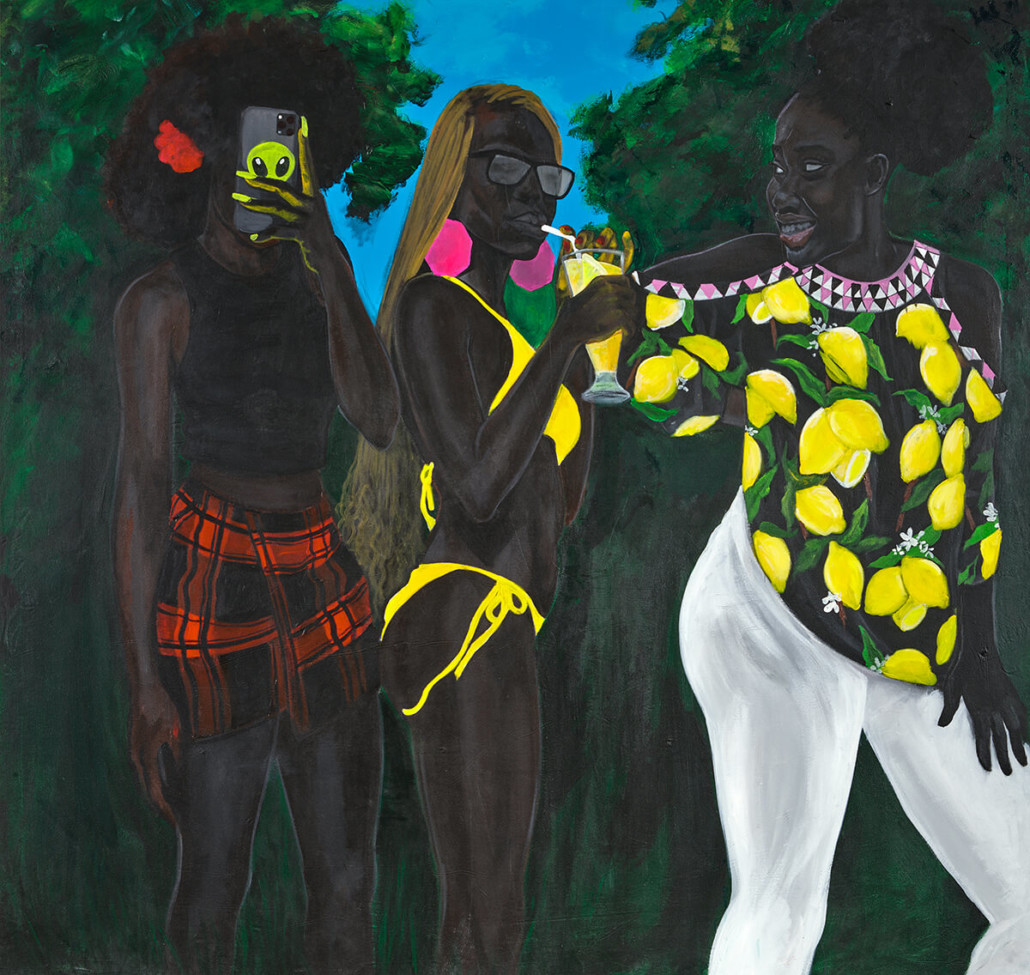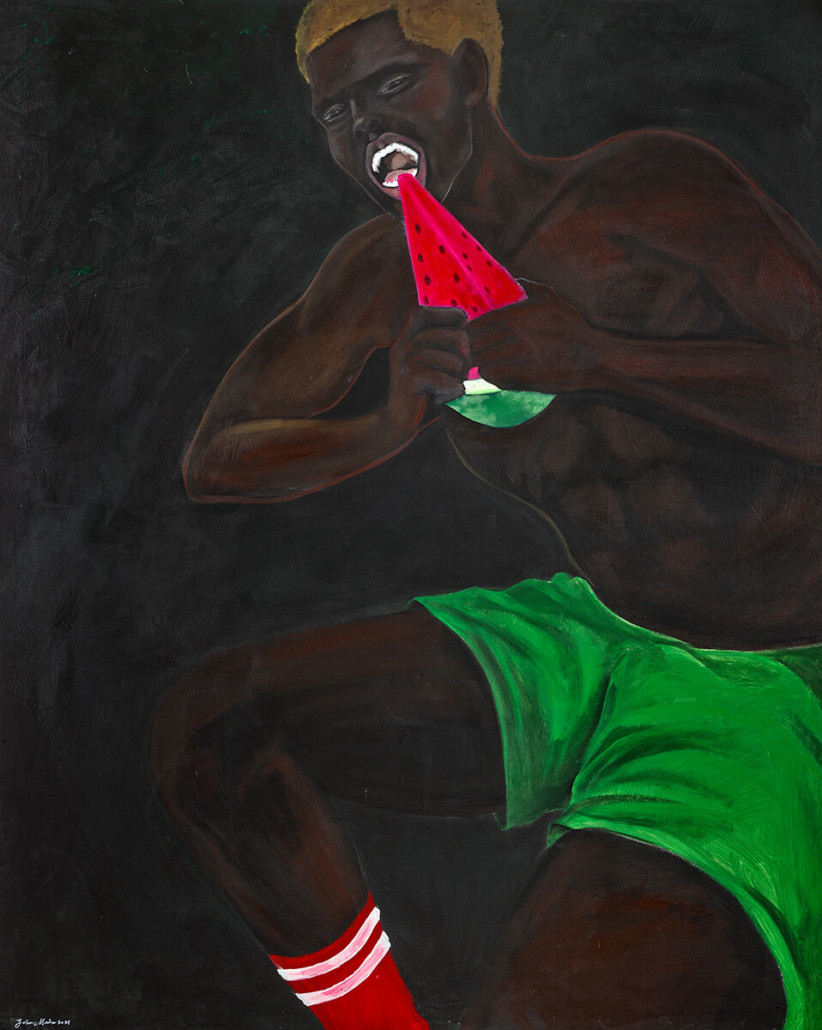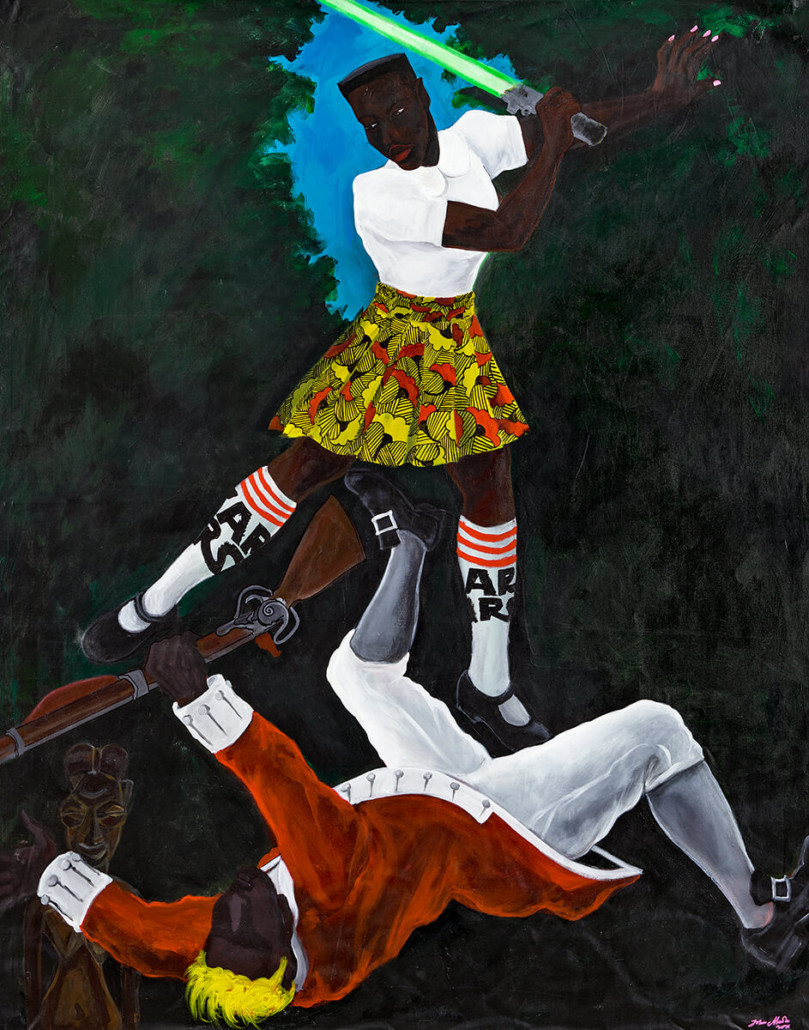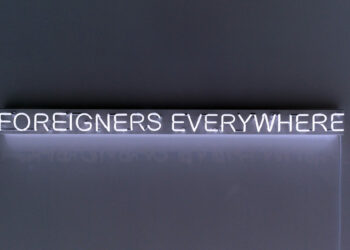‘A Loop In Time’ is an exhibition of paintings exploring figures of power through identity, emotion and time, reinterpreting narratives in history to fit into a contemporary discourse concerning social and political debates. Madu’s latest body of work consists of subjects that have evolved through his practice over the years. He plays with recognisable iconography from history and popular culture to compose symbolistic fun and appealing visual languages. Madu gives us some insight into three of the works on display in the exhibition.
Judgement of Paris (we are the gift)

John Madu, Judgment of Paris (we are the gifts), 2021. Acrylic on canvas, 173 x 182cm. Courtesy of the artist & Zidoun-Bossuyt Gallery.
his work is part of a series of paintings with the subject culled from Greek mythology, with a popular depiction by Peter Paul Rubens. The Judgement of Paris was a contest between the three most beautiful goddesses of Olympos for the prize of the golden apple addressed ‘to the fairest’.
I was inspired by conversations on social media surrounding women not supporting other women, which led me to learn about ‘Queen Bee Syndrome’, a term coined in 1973, mainly in the corporate environment where midlevel women feel a lack of support from more senior women.
When creating this piece, I had my mind on a reversal to the stereotype that women don’t support each other, I positioned the characters in the painting close to each other because I believe a woman alone has power, but as a collective can make an impact concerning important issues, by channelling the power of collaboration.
Maleek: Of Skin and Stereotype 2

John Madu, Maleek: Of skin and stereotypes II, 2021. Acrylic on canvas, 180 x 144cm. Courtesy of the artist & Zidoun-Bossuyt Gallery.
This painting is a second version of an initial work I created in 2020, inspired by a caricature of a black boy in an old poster printed from the year 1863. The young black boy (picanniny) eating a very large water melon, almost as big as he is, underneath this picture had a caption which defamed Africans and their American descendants. This made me look for more similar posters and found out the cartoonists depicted the African eating watermelons that were exaggerated by its size, to depict the Blackman having an unusual voracious appetite for the fruit.
These images led to discussions and research made me find out how watermelons were originally a symbol of freedom and black sufficiency for the just then emancipated slaves after the civil war in the 1860’s. Free black people grew, ate, and sold watermelons and made this a symbol of their freedom. Southern whites were threatened by this new found freedom and responded by making the fruit a symbol of black peoples perceived laziness and uncleanliness and unwanted public presence. The watermelon became a stereotype and been viewed as a major symbol in the iconography of racism in the United States. Why is so much meaning attributed to a fruit? It is evident that cultural symbols have the power to shape how we view our world and the people in it. I am of the CLA hook of thought that intolerance can be used to teach tolerance. From my trip through art history this painting is styled after a painting by Goya, titled Saturn eating one of his sons.
Not this time invader VII

John Madu, Not this time invader VII, 2021. Acrylic on canvas, 180 x 144cm. Courtesy of the artist & Zidoun-Bossuyt Gallery.
This painting is a part of a large body of work exploring subjects of time, history, identity, globalisation and neo-colonialism. Initially, the universal conversations about repatriating Africa’s looted art inspired me. Made me think why weren’t the artist’s tagged artisan’s at that time weren’t documented. My playful approach to this subject is a way I cushion such serious issues. The red wearing colonial soldier has been a reoccurring character in these paintings.
John Madu is a Nigerian multi-disciplinary artist born in Lagos, best known for his figurative, symbolic paintings. His work can be described as eclectic because of how he derives ideas from various influences and sources based on popular culture, African history, art history, and personal experiences. Symbolism is usually evident in his work, with reoccurring iconographies such as books, paintings, and other recognisable items which convey a particular meaning in art and act as metaphors to a subject.
John Madu conveys personal narratives through allegories in his vibrant paintings. His subjects, usually depicted within their intimate domestic spaces, seemingly pose or are caught in mid-reflection. John Madu pays careful attention to the symbolism of the objects in his portraits, finding hidden meanings in the routine decor of the house. Artworks are hung on the bedrooms and living rooms walls using surreal colours, including orange hair and pink walls. The quiet subtleties of his objects come out in the small details: the texture of the popular Ankara wax fabric, the pattern of a Ghana-must-go bag, the curved design of a table lamp, etc.
With a B.sc in policy and strategic studies, John Madu has taught himself, how to follow a natural flow of research and idea development, exploring all possible concepts, until it is innovative and ready for high-quality production, and above all to embrace his individual style, with a wide array of mediums such as acrylic paint, oil paint, spray paint, ink, burlap and collage. His multi-disciplinary approach has guided his creative interest in design objects, sculpture, functional art, and even artistic fashion pieces. Madu’s art has been featured in contemporary art exhibitions locally and internationally. He has collaborated with international brands such as DIESEL and Bombay Sapphire and believes art should be perceived as a time continuum like the way we see nature and an instantaneous reflection of the creative part of ourselves being expressed, when a viewer comes in contact with his work.
‘A Loop In Time’ will be on view from the 13th of November until the 24th of December 2021 at Zidoun-Bossuyt Gallery. For more information, please visit zidoun-bossuyt.com



